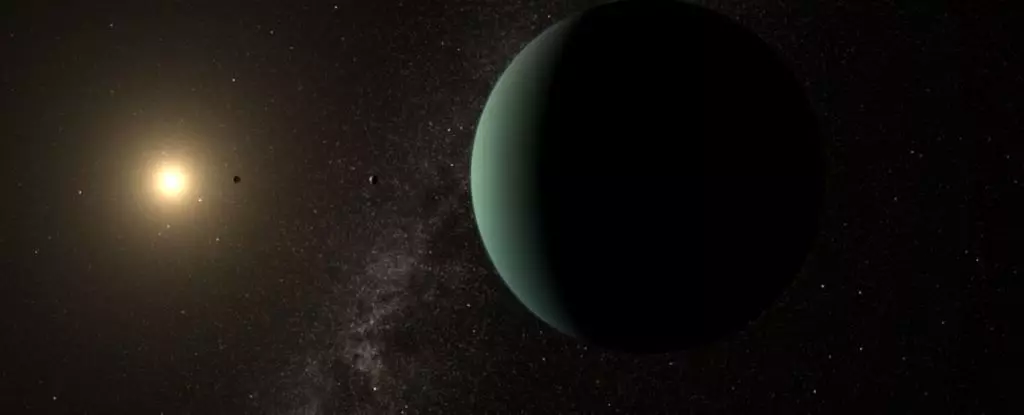In the vast and mysterious realms of space, scientists have recently unearthed evidence of a nearby exoplanet that may harbor conditions conducive to life. This newfound exoplanet, designated HD 20794 d, is an intriguing prospect located merely 20 light-years from our own Solar System. With a mass nearly six times greater than Earth’s, this celestial body orbits a star resembling our Sun, making the quest for extraterrestrial hosts in our vicinity not only exciting but also plausible. The discovery raises profound questions about the potential for life beyond Earth, echoing our deepest cosmic hopes.
The search for life beyond our planet hinges on the concept of the habitable zone, a region around stars where the conditions are just right for liquid water—a fundamental element for life as we know it—to exist. Planets located too close to their stars risk scorching any water away, while those situated too far may find their surfaces engulfed in ice. HD 20794 d orbits its star within this golden range, suggesting that water could persist on its surface in liquid form, assuming other conditions are met. This delicate balance makes HD 20794 d a world of great interest for astronomers and astrobiologists alike.
Notably, the star HD 20794 is a yellow dwarf, akin to our Sun, but slightly smaller in size and older. This evolutionary stage suggests that it provides a relatively stable atmosphere, offering any orbiting planets a chance to establish conditions suitable for life over extended periods. Given that planets undergo significant transformation over millions of years, such stability in the stellar environment is key to understanding whether they could support life.
The confirmation of HD 20794 d’s existence was not a straightforward endeavor. Initial hints of this planet emerged as early as 2011, when three other exoplanets were detected orbiting the same star. However, concrete evidence of HD 20794 d only materialized in 2022, when advancements in observational astronomy facilitated a more nuanced analysis of the star’s spectral data. Michael Cretignier, an astrophysicist at Oxford University, played a pivotal role in this breakthrough by identifying a faint periodic wobble in the star’s light spectrum. This wobble suggested that an unseen exoplanet was exerting gravitational influence on the star, thus revealing its presence.
The initial detection posed significant challenges for researchers, as the signals were faint and required meticulous scrutiny. Cretignier and his team utilized the European Southern Observatory’s ESPRESSO instrument to secure further observations, ultimately leading to a clearer picture of HD 20794 d’s characteristics. The culmination of such efforts provides a strong foundation for future explorations.
Despite its promising location within the habitable zone, HD 20794 d presents some challenges. Primarily, its elliptical orbit indicates that it does not remain consistently within the habitable zone; only portions of its orbit provide the right conditions for liquid water. At its apastron—the farthest point from its star—it ventures into regions too cold for water to remain in liquid form, raising concerns about its overall habitability.
Another significant uncertainty surrounding HD 20794 d is its size and density. With radius estimates ranging from 1.7 to 2.1 times that of Earth, determining its exact composition remains elusive. Should it prove to be less dense, it might exhibit characteristics akin to rocky super-Earths, enhancing the possibility of habitability. Conversely, if it is determined to be more substantial, it could share similarities with gas giants like mini-Neptunes, which could limit the chances of supporting life. Further studies will clarify these aspects and deepen our understanding of this intriguing exoplanet.
The discovery of HD 20794 d beckons the scientific community to reimagine the boundaries of our search for life in the universe. Its proximity—merely 20 light-years away—offers an unprecedented opportunity for future space missions to obtain direct imaging or more refined data. The ability to analyze the atmosphere, composition, and potential biosignatures of HD 20794 d could reshape our understanding of life’s resilience and adaptability.
As astronomers and astrobiologists continue their quest to uncover more about HD 20794 d and other exoplanets, one truth remains evident: the universe brims with possibilities. The tantalizing prospect of a habitable world residing in our cosmic neighborhood invites hope and inspiration, encouraging humanity to expand its horizons in the search for life beyond Earth. Whether or not our celestial neighbor can ultimately host life is still unknown, but the journey to uncover the truth will undoubtedly enrich our understanding of the cosmos.


Leave a Reply